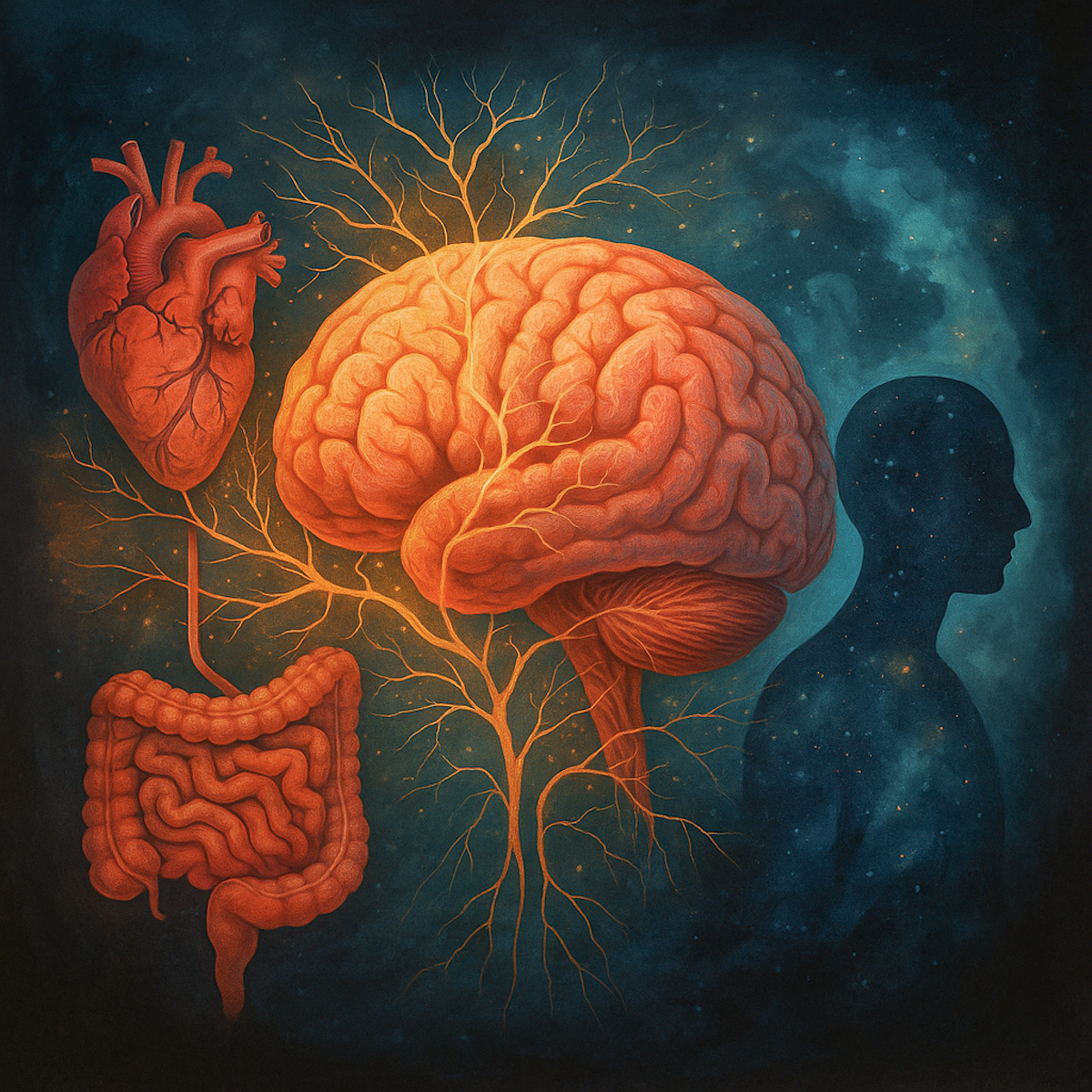This article is the first in a two-part series exploring the many ways we are woven into the world around us. Part one looks at the body — the tangible, physical exchanges that show how inseparable we are from our environment. Part two will turn toward the mind, exploring the subtler threads of perception, awareness, and consciousness that connect us in ways less visible but no less real.
PART 1.
Where do you end, and where does the universe begin? At first glance, the answer seems simple: the edge of your skin, the outline in the mirror, the “me” distinct from everything else. Yet when you pause and look closer, the boundary dissolves. Your body is never a closed container but a flowing exchange. Breath, touch, sound, light, even invisible particles — all enter and leave you in an endless cycle of mingling with the world.
The science of entanglement
Each breath draws the outside in and releases the inside out. With every inhale, you’re not only taking in oxygen but also a vast mix of other molecules — nitrogen, carbon dioxide, water vapor, trace gases, even microscopic particles drifting in the air. With every exhale, you offer something back — That Oxygen you just breathed in has now mingled with your cels, creating Energie for your life and in the process creating carbon dioxide that leaves your body when you exhale. Trees may soon drink it in, transforming it once again into oxygen. That very oxygen could then fuel the wing muscles of a bird in flight. This cycle of respiration has been happening since the dawn of life, binding us into one great breathing organism.
Your skin, often thought of as a barrier, is more like a shimmering membrane. Every day, millions of cells flake off into the air, drifting into rooms, onto other bodies and into the soil. At the same time, your skin is constantly responding to the atmosphere around it — absorbing light and heat, registering the subtle shifts of air pressure, drinking in or releasing moisture depending on humidity. Even before you’re aware of it, these invisible exchanges shape how you feel as a person in your body. And through touch, another layer opens: the handshake, the caress, the press of a palm. These are not just sensations but chemical events, triggering cascades of hormones like oxytocin, subtly shifting heart rhythms and brain states. Covering all of this is the skin’s own microbiome — a thriving community of bacteria, fungi, and microscopic life that lives with us, on us, and for us. It too is in constant dialogue with the environment, protecting us, adapting, and shaping how our inner and outer worlds meet.
The microbiome in your gut is another portal of exchange. You carry trillions of bacteria, viruses, and fungi — a living ecosystem fed by the world around you. Every bite of food is not just calories but also information, shaping the composition of this inner forest, which in turn influences mood, immunity, even decision-making. You are, in a very real sense, partly other. And this ecosystem is never fixed: when you travel, it shifts almost immediately, absorbing new influences from food, water, air, and soil. Within days, your inner community reflects the outer one, sending signals through the body about the new environment you’ve entered — a living mirror of your surroundings, woven into your biology.
Beyond your breath, skin, and gut, there is also the silent language of scent. With every interaction, we exchange chemical signals — pheromones, sweat molecules, and subtle hormonal traces — that carry information our conscious mind rarely registers. These invisible messengers shape our impressions of others, influence attraction, signal stress or calm, and give us clues about the emotional weather of our surroundings. Long before words are spoken, your body has already “read” the atmosphere, tuning itself to the chemistry of those nearby. Unconsciously you have woven your inner feelings and chemical state into your environment.
And then, there is entanglement in the quantum sense. Physicists describe a phenomenon where particles that once interacted can remain correlated even when separated by great distances. At human scale, the direct effects are subtle, we don’t know how these interaction actually affect us. Yet the idea gestures toward a larger truth: the very atoms and particles that compose you have histories — they once belonged to stars, oceans, soils, and other bodies. If particles can stay linked after long separation, it is a poetic and reasonable leap to imagine that the web of relationships among matter stretches back through deep time and forwards into the future. The particles assembling into you and creating your body today have been in contact, exchange, and transformation since the universe began. If the Theorie of entanglement is as it currently seems, it would suggest that we are literally never separated and actions have consequences across space in real time. Whether or not distant galaxies are nudging our atoms through quantum links in ways we don’t yet measure and vice a versa, the more immediate fact remains: you are composed of matter that has always been in conversation with the rest of the cosmos.
We also live inside and generate electrical and electromagnetic fields. Your heart and brain produce measurable fields (ECG and EEG), and most cellular communication in the body runs on electric signals and ion flows. These fields create a kind of invisible shimmering halo around us and are constantly interacting with the environment — from the Earth’s magnetic field to the local electromagnetic landscape of a room. While the precise effects of ambient fields on everyday human experience are an active area of research, the basic fact is clear: much of the information in our bodies is electrical, and those signals are both sent and received, opening another channel through which we are continously in conversation with the world.
The felt reality
What does it mean to notice this? To sit quietly and realize that your next breath is yours, yet never yours alone — it belongs also to trees, oceans, strangers, animals — the whole breathing planet. To know that the warmth on your skin is not only the heat your body releases, but also the energy of sunlight that left the surface of the sun just eight minutes ago. That the sounds you hear right now — the rustle of leaves, the hum of traffic, the voice of a friend — is vibration moving directly through you, joining the sounds your own body makes — the pulse of your heartbeat, the rhythm of your breath, the resonance of your voice — shaping your nervous system in ways both subtle and profound.
And while all this is happpening, your body is alive with those fields and signals. The electromagnetic pulse of your heart and brain extends outward, interacting and synchronizing with the space and people around you. Your skin and gut microbiomes are sending streams of chemical signals, responding to food, air, touch, and presence. Within you, countless messengers — hormones, neurotransmitters, peptides — are released in response to this symphony of exchange, shifting your mood, coloring your perception, and composing your sense of who you are right now.
To feel this is to realize that identity is not a fixed essence but a living process — an improvisation shaped in every moment by the dance between your body and the world.
It can feel unsettling, this loss of solidity. But it can also feel like a relief: the sense that you are not a lonely island, but a thread woven into a vast, living tapestry.
The philosophy of exchange
When you follow these threads, individuality itself begins to shimmer and blur. The “self” is not a fixed thing but a process — an ongoing dance of exchanges with the Umwelt. What you call “me” is a whirlpool of particles, vibrations, and energies, swirling in a momentary pattern before continuing on their way.
We often speak of identity as something to be defended, a line that must not be crossed. Yet the reality is that identity is made of crossing — of countless inputs and outputs, of blending and entanglement. We are not separate beings trying to connect; we are already connection, temporarily shaped into form.
The spiritual undertone
If this is true, then perhaps separation itself is the illusion. What you breathe in today may have passed through countless others before you. The water in your body once coursed through rivers, clouds, and ancient seas. The calcium in your bones was forged in the heart of a long-dead star. To feel this is to remember that belonging is not something to earn — it is the fundamental condition of existence.
In many traditions, this truth has been intuited for centuries. “All is one,” say the mystics. Science, in its own way, is now mapping the same terrain, revealing the deep entanglement of matter, energy, and life.
An invitation
So what happens if you live with this awareness? If you move through your day not as a sealed container but as an exchange — a participant in the endless dance of giving and receiving? Does it soften the edges of fear and loneliness? Does it bring more reverence to the ordinary acts of breathing, eating, listening, touching?
Perhaps the real frontier is not discovering our separateness, but daring to live as though we are already woven into the whole — because we are.
And this is only half the story. In part two, we’ll turn from the body to the mind — to explore how thoughts, perceptions, and consciousness itself may be just as entangled with the world around us as our breath and our skin.
Disclaimer: While the inspiration and most of the writing in this article arose in my mind and is my creation and reflects my deep passion for finding the golden threads that connect us all beyond race, religion, culture. I used ChatGPT during the process.




